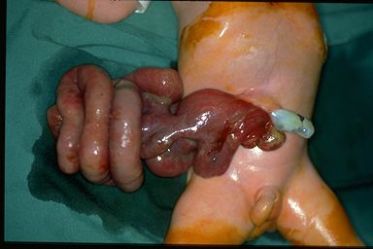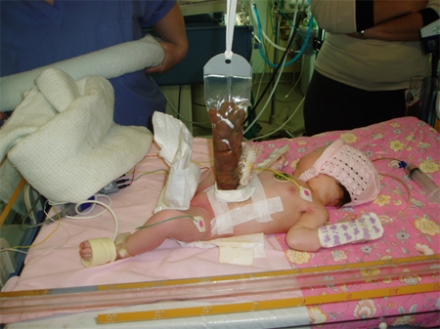(Image courtesy of: http://www.dfwareamoms.com/forums/showthread.php?t=53861)
GASTROSCHISIS is a condition where there is a defect at the anterior abdominal wall (usually towards the right of the umbilical cord insertion), leading to the evisceration of the intestinal segments or abdominal contents as seen in the picture above. Because of this, the intestines is now exposed to the amniotic fluid where the baby floats. (Amniotic fluid is made up mostly of the fetus’ urine, thus may contain chemicals that can be irritating to the intestines but not to the baby’s skin). This exposure triggers the intestines to react to the amniotic fluid, causing inflammatory response, thickening of the intestinal walls than their regular diameter when not exposed to amniotic fluid. If an operation is attempted immediately at birth, it would be impossible to put back all those intestines into the abdominal cavity at once hence a silo bag is placed to contain the intestines outside of the abdominal cavity. Slowly the intestinal contents in the silo bag is pushed (in days or weekly basis) until the abdominal cavity is able to contain everything, thus the wound is now closed.
Intestines contained in a silo bag. (Image courtesy of http://bestpractice.bmj.com/best-practice/monograph/883/resources/image/bp/3.html)
AMNIO-INFUSION
The abdominal wall is sterilized. Then under ultrasound guidance, a needle is poked into the amniotic cavity. Amniotic fluid is then aspirated, and then an equal amount of normal saline solution is replaced back. This is then repeated until the return flow becomes clear in color. This is being done in order to refreshen the amniotic fluid that might irritate and cause inflammation of the intestines that has eviscerated outside the abdominal cavity (as you recall that the amniotic fluid is mainly composed of the fetus’s urine). If the intestines become inflamed, the abdominal cavity might not be able to contain everything when replaced all at once during a corrective operation.
———-
I was lucky again to have witnessed a case of a baby with gastroschisis, diagnosed prenatally via an ultrasound, and who underwent the above procedure. The perinatologist did serial amnio-infusion treatment on the baby (of course, while mom still pregnant with him) until the time that delivery was already inevitable. During one of the amnio-infusion treatment, I was a witness and assisting the perinatologist. The postnatal outcome was marvelous!
During delivery, we did a double set-up at the operating room. At one room was the cesarean section for the delivery of the baby. At the other room was the team of the pediatric surgeon waiting. We, the neonatology team was in between. A sterile plastic container was readily available. When the baby was out of the mother’s uterus, we the neonatology team attended to the baby immediately. We were so lucky that baby was vigorous upon delivery so there was no need to help him breath. Immediately while my colleague was wiping baby dry off the amniotic fluid, I was inserting a line and my other colleague was putting the baby’s legs, intestines and his lower trunk into the sterile plastic. This is to avoid losing much fluid from the abdominal cavity and contaminating the intestines and abdominal cavity. Then we immediately brought baby to the other operating room where the pediatric surgeon was waiting.
Primary closure (all intestines brought inside the abdominal cavity at once) was done on baby. This was easily possible because the intestines weren’t that much inflamed, thanks to the amnio-infusion, thus the abdominal cavity was able to accommodate them all. I wasn’t sure though if all layers of the abdomen were co-aptated and sutured all together, or just the skin and the subcutaneous layer, my bad not to have remembered.
The baby was able to tolerate feeding immediately. Because of this, the baby did not stay long in the hospital, went home in less than two weeks if I was not mistaken. I guess this is another benefit of amnio-infusion – avoid prolonged hospitalization and thus hospital acquired infections. I wish to do this again, now that I am in private practice.

